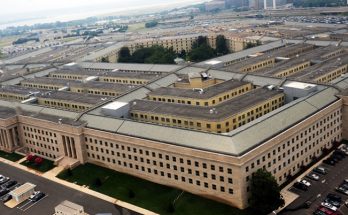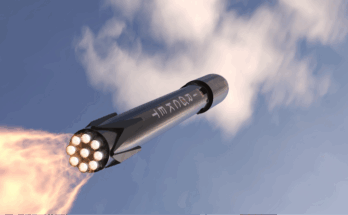
Germany, France, and Spain’s Future Combat Air System (FCAS) program represents a major European tri-national effort to design and build a sixth-generation fighter aircraft. Similar to related fighter programs, like the U.S. Air Force’s Next Generation Air Dominance (NGAD) and the U.K./Italy/Japan Global Combat Aircraft Program (GCAP), FCAS features a networked approach employing a suite of integrated systems. The project includes a New Generation Fighter (NGF) that will operate in concert with autonomous air platforms called Remote Carriers (RC), all communicating via a cloud-based datalink with complementary assets in the air, ground, space, and cyber domains.
An FCAS primary objective is the production of an advanced next-gen fighter replacement for each of the partner nations. The German and Spanish air forces’ legacy Eurofighter Typhoons and France’s Dassault Rafales are expected to be supplanted by the FCAS NGF. The project will integrate advanced technologies to include elements of augmented reality. Geopolitically, FCAS is likely to bolster NATO air superiority and hedge against Eastern air threats in the European region, perhaps to counter a potential enhanced sixth-generation Su-57. Trilateral officials hope to bring the full program and fighter platform to operational status by 2040, though this goal is likely overly optimistic.
Origins and Timeline
The FCAS effort was first revealed to the public in a joint July 2017 press conference in Paris by German Chancellor Angela Merkel and French President Emmanuel Macron. In 2018, following an agreement by the German and French governments, CEOs from France’s Dassault Aviation and Airbus announced their respective companies would lead the FCAS project, with Dassault tasked with primary development of the NGF.
At the 2019 Paris Air Show, Spain announced it was officially joining the Franco-German collaboration as the third contributing member. Of note, while the tri-nation venture has been primarily referred to as FCAS, it has also been branded in Spain as Système de Combat Aèrien Futur (SCAF) and often grouped as FCAS/SCAF.
The project moved into Phase 1A, an 18-month contract to begin work on the FCAS demonstrator, in early 2020 after Germany and France signed on Dassault and Airbus. After a delay, in part due to contractor disagreements, a follow-up Phase 1B demonstrator contract was awarded at the end of 2022, with additional contractors added from each nation. Phase 1B is expected to be completed by 2025.
Another major milestone came at the 2023 Paris Air Show when President Macron announced the inclusion of Belgium as a partner nation, though at this time Belgium’s participation status is limited to an observational role.
Phase 2 will unfold following Phase 1B with the goal of a Remote Carrier demonstrator flight in 2028 and an NGF flight in 2029. Currently, FCAS officials plan for production to occur sometime in the 2030s.
Budget and Partners
Though Belgium’s recent addition to the FCAS project as an observer is unlikely to signify a current vested financial or development contribution, it does suggest the possibility for FCAS to expand its member partnerships in the future. The phased development approach to FCAS has led to segmented contracting and funding as the program progresses.
Initial funding was first allocated by Germany and France to Dassault and Airbus under the two-year Joint Concept Studies (JCS) in early 2019 for EUR65 million. Next, the 2020 Phase 1A demonstrator development contract saw France and Germany each apply EUR77.5 million with the announcement of Spain as a fully integrated partner at the end of the year. The trilateral effort launched its next step in December 2022, with the Phase 1B demonstrator component jointly funded for EUR3.2 billion.
Overall program costs can only be estimated for such a complex and expensive endeavor, yet the French government previously projected a total investment for all partners of EUR50-EUR80 billion. Current projections anticipate total development and production costs will breach EUR100 billion.
Suppliers
The FCAS initiative truly represents a European consortium, with a growing list of contractors assigned to various project parts. FCAS progress currently sits in Phase 1B, where Dassault Aviation, Airbus, Indra, and EUMET serve as the prime contractors, with subcontractors sourced from each of the three countries. This phase is organized around nine distinct technology pillars, or domains: NGWS consistency, NGF, NGF twin-engine, unmanned systems (RCs), Combat Cloud (CC), Simulation, Sensors, Low Observability (stealth), and Common Working Environment (CWE).
In addition to the prime contractors, the team also includes ITP (Spain), MBDA (France and Germany), SATNUS (Spain), Thales (France), and FCMS (Germany), which each handle assignments distributed among the pillars.
Export Market and Outlook
While the health of FCAS seems rocky at times due to internal tensions, the program scope and multinational investments could position the effort to be a successful one. The economies, labor markets, and defense industries of Germany, France and Spain are likely to benefit over the next several decades because of FCAS participation.
As they are for parallel sixth-generation fighter projects, NGAD and GCAP, estimates of aircraft acquisition numbers for FCAS a dozen or more years out from operational capability are approximations at best. Since FCAS will serve as a successor to each nation’s 4.5-generation Typhoon and Rafale fighters, it’s logical to expect Germany and France to procure the lion’s share of NGFs, followed by Spain, for a total easily reaching the few-hundred-aircraft range.
Exportability details regarding the NGF also remain unclear, though early reports signaled possible friction between France’s more progressive export policy and Germany’s stricter views on arms sales. Nonetheless, program officials have noted the shared desire to agree upon a mutual export strategy for FCAS.
With a similar development and production goal as GCAP, the FCAS NGF will likely compete with the GCAP aircraft for next-generation fighter sales in the European market and possibly with NGAD if it is released for exports. The latest addition of Belgium, albeit as an observer, is a promising sign for the European collaboration and suggests the possibility of future global partners and buyers.
However, recent news from the 2023 Paris Air Show reveals the program is again experiencing hurdles. On the heels of the Belgium announcement, Dassault CEO Eric Trappier reportedly cast doubt on the 2040 operational timeline, estimating a date closer to 2042-2044. Critics also sharply noted the project’s slow headway, infighting, and lack of observable progress compared to GCAP’s more steady status.
Related Briefers
BRIEFER: Global Combat Aircraft Program (GCAP)
BRIEFER: Next Generation Air Dominance (NGAD) – U.S. Air Force
BRIEFER: Future Combat Air System (FCAS)
Forecast International’s Military Aircraft Forecast reports on fixed-wing military aircraft of all types – fighters, military transports, military trainers, and special mission aircraft – worldwide. Full coverage of leading programs such as the Lockheed Martin F-35 Joint Strike Fighter (JSF), the Dassault Rafale, the Saab Gripen, the Airbus A400M, the Beechcraft T-6, the Embraer Super Tucano, the Pilatus PC-21, and the Boeing KC-46A, among others. For more information, click here.
A former naval officer and helicopter pilot, Jon covers a range of Forecast International reports and products, drawing on his 10-year background in military aviation, operations, and education. His previous military assignments include multiple overseas deployments supporting operations in the Arabian Gulf, NATO exercises, and humanitarian missions. Jon’s work is also influenced by his time as a former Presidential Management Fellow and international trade specialist at the Department of Commerce.
Before joining Forecast International, Jon also served as an NROTC instructor and Adjunct Assistant Professor at the University of Texas, where he taught undergraduate courses on naval history, navigation, defense organization, and naval operations and warfare. A lifelong reader and learner, his academic and professional interests include aviation, political and military history, national defense and security, and foreign area studies.




